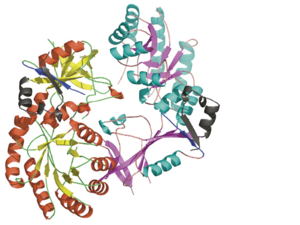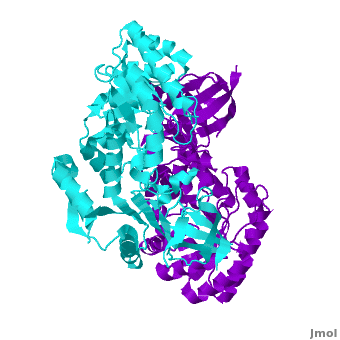Antizyme Inhibitor
From Proteopedia
| Line 23: | Line 23: | ||
<applet load="3BTN.pdb" size="300" color="white" frame="true" align="left" scene='Antizyme_Inhibitor/Azi/1' spinBox="true" /> | <applet load="3BTN.pdb" size="300" color="white" frame="true" align="left" scene='Antizyme_Inhibitor/Azi/1' spinBox="true" /> | ||
| - | Each <scene name='Antizyme_Inhibitor/Monomer/5'>monomer</scene> consists of two domains: a <scene name='Antizyme_Inhibitor/Monomer/6'>TIM-like</scene> α/β-barrel [http://en.wikipedia.org/wiki/TIM_barrel] domain (residues 45–280) and a modified <scene name='Antizyme_Inhibitor/Monomer/7'>Greek key</scene> [http://en.wikipedia.org/wiki/Greek_key] β-sheet domain (residues 8–44 and 281–435). Helices are colored in red and β strands in yellow. | + | Each <scene name='Antizyme_Inhibitor/Monomer/5'>monomer</scene> consists of two domains: a <scene name='Antizyme_Inhibitor/Monomer/6'>TIM-like</scene> α/β-barrel [http://en.wikipedia.org/wiki/TIM_barrel] domain (residues 45–280) and a modified <scene name='Antizyme_Inhibitor/Monomer/7'>Greek key</scene> [http://en.wikipedia.org/wiki/Greek_key] β-sheet domain (residues 8–44 and 281–435). <font color='red'><b>Helices</b></font> are colored in <font color='red'><b>red</b></font> and <font color='yellow'><b>β strands</b></font> in <font color='yellow'><b>yellow</b></font>. |
{{Clear}} | {{Clear}} | ||
| Line 30: | Line 30: | ||
| - | A | + | A sequence alignment and <scene name='Antizyme_Inhibitor/Azi_odc/10'>structural comparison</scene> of mouse AzI crystallographic dimer (mAzI, <font color='cyan'><b>cyan</b></font> and <font color='blueviolet'><b>blueviolet</b></font>) to mouse, human, and trypanosome ODC (mODC (PDB code [[7odc]], <font color='red'><b>red</b></font> and <font color='lime'><b>lime</b></font>), hODC, and tODC, respectively) show high sequence identity (~50%) and structural similarity between AzI and ODC monomers (RMSD values of 1.85 Å, 1.6 Å, and 1.5 Å, respectively). Superposition of the <scene name='Antizyme_Inhibitor/Azi_odc/11'>interface</scene> of mAzI and mODC showing the inter-subunit variable loops (AzI residues 355–362 and 387–401). <font color='black'><b>AzI loops</b></font> are in <font color='black'><b>black</b></font>, and <font color='yellow'><b>ODC loops</b></font> are in <font color='yellow'><b>yellow</b></font>. |
{{Clear}} | {{Clear}} | ||
Revision as of 14:39, 25 December 2008
Crystal structure of the Antizyme inhibitor
| |||||||
| AzI, unpublished structure | |||||||
|---|---|---|---|---|---|---|---|
| Coordinates: | save as pdb, mmCIF, xml | ||||||
Antizyme inhibitor (AzI) regulates cellular polyamine homeostasis by binding to the polyamine-induced protein, Antizyme (Az), with greater affinity than ornithine decarboxylase (ODC). AzI is highly homologous to ODC but is not enzymatically active. In order to understand these specific characteristics of AzI and its differences from ODC, we determined the 3D structure of mouse AzI to 2.05 A resolution. Both AzI and ODC crystallize as a dimer. However, fewer interactions at the dimer interface, a smaller buried surface area, and lack of symmetry of the interactions between residues from the two monomers in the AzI structure suggest that this dimeric structure is nonphysiological. In addition, the absence of residues and interactions required for pyridoxal 5'-phosphate (PLP) binding suggests that AzI does not bind PLP. Biochemical studies confirmed the lack of PLP binding and revealed that AzI exists as a monomer in solution while ODC is dimeric. Our findings that AzI exists as a monomer and is unable to bind PLP provide two independent explanations for its lack of enzymatic activity and suggest the basis for its enhanced affinity toward Az.
Crystallographic and biochemical studies revealing the structural basis for antizyme inhibitor function., Albeck S, Dym O, Unger T, Snapir Z, Bercovich Z, Kahana C, Protein Sci. 2008 May;17(5):793-802. Epub 2008 Mar 27. PMID:18369191
From MEDLINE®/PubMed®, a database of the U.S. National Library of Medicine.
|
Each consists of two domains: a α/β-barrel [1] domain (residues 45–280) and a modified [2] β-sheet domain (residues 8–44 and 281–435). Helices are colored in red and β strands in yellow.
|
A sequence alignment and of mouse AzI crystallographic dimer (mAzI, cyan and blueviolet) to mouse, human, and trypanosome ODC (mODC (PDB code 7odc, red and lime), hODC, and tODC, respectively) show high sequence identity (~50%) and structural similarity between AzI and ODC monomers (RMSD values of 1.85 Å, 1.6 Å, and 1.5 Å, respectively). Superposition of the of mAzI and mODC showing the inter-subunit variable loops (AzI residues 355–362 and 387–401). AzI loops are in black, and ODC loops are in yellow.
AzI crystallizes as a dimer such that the two monomers adopt a head-to-tail orientation similarly to the ODC dimer. The two AzI monomers demonstrate only (up 3.5 Å), while significantly more contacts are observed between the two monomers of hODC, mODC, and tODC (83, , and 69, respectively). Moreover, the surface area buried by the two AzI monomers is smaller than that buried by the mODC monomers. These properties support a very weak crystallographic dimer.
Conserved hydrophobic residues in ODC form a zipper that stabilizes its homodimeric structure. These residues include F397(B), Y323(B), Y331(A), Y331(B), Y323(A), and F397(A) (the names of the chains are in brackets). An important residue Y331 in the is substituted to S329 in AzI and interferes with the formation of a similar zipper in AzI. So, showing the absence of the hydrophobic zipper. Many residues, that participate in the ODC interface interactions, are conserved among the ODCs from various species, but are different in AzI. Moreover, the residues that are conserved in AzI do not participate in interdimer interactions. These residues include the , K169–D364 and D134–K294, which stabilize the ODC homodimer. In AzI, all these 4 residues (, respectively) are conserved, but these two salt bridges are not formed. Two AzI monomers are positioned apart one from an other, in comparison ot ODC monomers, preventing the formation of interdimer interactions.
|
PLP-dependent enzymes have conserved active-site residues, implying that they have similar PLP binding sites. of the AzI and ODC structures suggests that AzI does not bind PLP. Many of the residues participated in PLP binding in ODC are not conserved in AzI. These include D88A, R154H, R277S, D332E, and Y389D (ODC residue numbering followed by the amino acid in AzI). Notably, the loss of even one of these interactions, as exemplified in the ODC R277A mutant, results in a 100-fold decrease in PLP binding as well as a 50% drop in Kcat and a 7-fold decrease in KM. PLP is in yellow, ODC residues D88, R154, R277, and Y389 are in green, and corresponding AzI residues A88, H154, S274, and D387 are in magenta.
Reference
Shira Albeck, Orly Dym, Tamar Unger, Zohar Snapir, Zippy Bercovich and Chaim Kahana. Crystallographic and biochemical studies revealing the structural basis for antizyme inhibitor function. Protein Sci. 2008 May; 17(5): 793-802. Epub 2008 Mar 27.
Proteopedia Page Contributors and Editors (what is this?)
Alexander Berchansky, Michal Harel, Joel L. Sussman, Dinesh Kulhary, David Canner, Jaime Prilusky, Orly Dym


